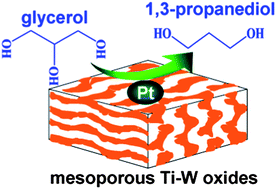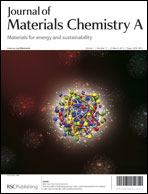Mesoporous Ti–W oxides, bearing high surface area, large pore volume, uniform pore size and tunable W/Ti ratios in a wide range (10–40 mol%), were successfully fabricated via an evaporation-induced self-assembly (EISA) strategy. In this approach, the incorporation of W species not only effectively resulted in well-ordered mesoporous structures when calcined below 400 °C but also modified the acidic properties of the obtained oxide composites. The optimal acid amounts (0.47–0.67 mmol g−1 for 400 °C calcinations, 0.25–0.27 mmol g−1 for 500 °C calcinations) were obtained when the W concentration was between 10 and 20 mol%. When calcined at 500 °C, Brønsted acids were generated in Ti90W10-500 and Ti80W20-500. The catalytic performance of these mesoporous solid acids in glycerol hydrogenolysis was studied with a loading of 2 wt% Pt. Pt/Ti100−nWn-500s exhibited high selectivity to 1,3-propanediol (33.5% and 40.3%) and promising catalytic activities (18.4% and 24.2% glycerol conversion) when n is 10 and 20, respectively. This work presents a step forward in the development of highly efficient glycerol hydrogenolysis catalysts and a new understanding of the reaction mechanism of glycerol hydrogenolysis to 1,3-propanediol.

You have access to this article
 Please wait while we load your content...
Something went wrong. Try again?
Please wait while we load your content...
Something went wrong. Try again?


 Please wait while we load your content...
Please wait while we load your content...